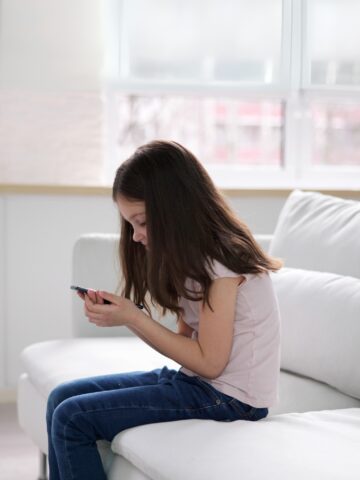How to get started with toilet training your child
Every parent of young children fantasizes about a world without diapers, wipes and hunching over a changing table.
But when is it time to begin potty training? And if you’ve already started the process without much luck, when is it time for concern?
In this ultimate guide to potty training, Dr. Swati Gandhi, a CHOC pediatrician, offers advice to parents.
When are kids ready to toilet train?
Many parents are unsure about when to start potty training. Not all kids are ready at the same age, so it’s important to watch your child for signs of readiness:
- the ability to follow simple instructions;
- understanding and using use words about the potty;
- making the connection between the urge to pee or poop and using the potty;
- keeping a diaper dry for two hours or more;
- getting to the potty, sitting on it for enough time, and then getting off the potty;
- pulling down diapers, disposable training pants or underwear; or
- showing an interest in using the potty or wearing underpants.
Most children begin to show these signs when they’re between 18 and 24 months old, though some may not be ready until later than that. And boys often start later and take longer to learn to use the potty than girls.
What are some early ways to start potty training?
Even if your child isn’t yet showing signs of potty training readiness, parents can still start laying the foundation for training success. Here are a few early steps to take:
- Use words to express the act of using the toilet, such as “pee,” “poop” and “potty.”
- Use proper words for body parts and functions.
- Ask your child to let you know when a diaper is wet or soiled.
- Identify behaviors (“Are you going poop?”) so that your child can learn to recognize the urge to pee and poop.
- Get a potty chair your child can practice sitting on. At first, your child can sit on it wearing clothes or a diaper. When ready, your child can go bare-bottomed.
When isn’t a good time to start potty training?
There are sometimes when you may want to put off starting toilet training, such as:
- when traveling;
- around the birth of a sibling;
- changing from the crib to the bed;
- moving to a new house; or
- when your child is sick.
How long does potty training take?
Teaching a toddler to use the potty isn’t an overnight task. It often takes between three and six months, but can take more or less time for some children. If you start too soon, the process tends to take longer. And it can take months to even years to master staying dry at night.
What kind of potties should I use?
When it comes to potty training, there are two toilet options:
- a standalone, toddler-size potty chair with a bowl that can be emptied into the toilet or
- a toddler-size seat that can be placed on top of a toilet seat that will let your child feel more secure and not fear falling in. If you choose this, get a stepping stool so your child can reach the seat comfortably and feel supported while having a bowel movement.
You may want to get a training potty or seat for every bathroom in your house. You may even want to keep a potty in the trunk of your car for emergencies. When traveling long distances, be sure to take a potty seat with you and stop every one to two hours.
Should boys start potty training standing up or sitting down?
It’s usually best for boys to first learn to use the toilet sitting down before learning to pee standing up. For boys who feel awkward — or scared — about standing on a stool to pee in the toilet, a potty chair may be a better option.
Should I use training pants when potty training?
Disposable training pants can be a helpful step between diapers and underwear. Because kids’ nighttime bladder and bowel control often lags behind their daytime control, some parents like using training pants at night. Others prefer that their child use training pants when they’re out and about. Once the training pants remain dry for a few days, kids can make the switch to wearing underwear.
There’s an alternate perspective that disposable training pants might make kids think it’s OK to use them like diapers, thus slowing the toilet-teaching process.
Your pediatrician can be a great help in determining which route is best for your child and family.
Potty training roadmap
So, you’ve decided your child is ready to start learning how to use the potty. Here is a step-by-step plan to help:
Model behavior
Children learn from watching their parents. So, show your child how you sit on the toilet and explain what you’re doing. You also can have your child sit on the potty seat and watch while you or a sibling use the toilet.
If your child poops in their diaper, empty it into the toilet. Show the child and explain that poop goes in the potty.
Create a potty routine
Potty training is a journey. So, when you’re ready, set aside time for the learning process.
You may want to begin by having your child sit on the potty after waking with a dry diaper, or 45 minutes to an hour after drinking lots of liquids.
Only put your child on the potty for a few minutes a couple of times a day, and let your child get up if he or she wants to. Never make your child sit on the toilet against their will.
Have your child sit on the potty 15 to 30 minutes after meals to take advantage of the gastro-colic reflex – the body’s natural tendency to have a bowel movement after eating. Also, many kids have a time of day they tend to have a bowel movement: Look for this and try to time potty trips strategically.
Ask your child to sit on the potty if you see clear clues of needing to go to the bathroom, such as crossing legs, grunting, or squatting.
Ensure all caregivers — including babysitters, grandparents and childcare workers — follow the same routine and use the same names for body parts and bathroom acts. Let them know how you’re handling toilet training and ask that they use the same approaches so your child won’t be confused.
Dress appropriately
Help set your child up for success by avoiding clothing that is hard to take on and off. Avoid things with buttons or snaps and look for loose clothing that pulls up and down easily. Some parents choose to keep kids naked during dedicated at-home periods of potty training.
Offer lots of praise and rewards
Heaping verbal praise and giving small rewards like stickers, little toys or candy can go a long way in helping encourage children learning to use the potty. Try keeping a chart that tracks success and offering a bigger reward after a long run of potty victories.
Parents ought to praise all attempts to use the toilet, even if nothing happens.
Don’t sweat accidents
Remember that potty accidents will happen. It’s important not to punish potty-training children or show disappointment when they wet or soil themselves or the bed. Instead, tell your child that it was an accident and offer your support. Reassure your child — and yourself — that they are well on their way to using the potty like a big kid.
What are some common toilet training setbacks?
Many kids who’ve been using the potty successfully have some trouble during times of stress. For example, a 2- or 3-year-old who has a new sibling in the home, recently moved, or is experiencing other changes or stress may start having accidents. Work through these setbacks with patience.
However, if your child was potty-trained and begins regularly having problems, talk with your pediatrician.
How old is too old not to be potty trained?
First, remember that children master the potty at different ages and by and large, most children will get there eventually. Take a deep breath and remember this is only a phase.
However, if your child is age 4 or older and hasn’t yet mastered the toilet, speak with your pediatrician.
For more health and wellness resources from the pediatric experts at CHOC, sign up for the Kids Health newsletter.
Find a CHOC Primary Care Pediatrician
From babies to teens, pediatricians from CHOC’s Primary Care Network partner with parents to offer immunizations, sick visits, sports physicals and more.






